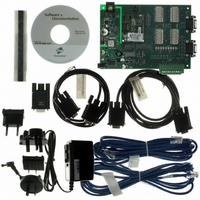DC-EM-KT Digi International, DC-EM-KT Datasheet - Page 143

DC-EM-KT
Manufacturer Part Number
DC-EM-KT
Description
KIT INTEGRATION EM FOR S MODELS
Manufacturer
Digi International
Series
Digi Connect EM®r
Type
MCU Moduler
Specifications of DC-EM-KT
Contents
Module with plug-and-play firmware, Development Board, Documentation, CD, Cables and Power Supply
For Use With/related Products
Digi Connect EM S Module
Lead Free Status / RoHS Status
Contains lead / RoHS non-compliant
Other names
602-1003
DC-EM-01T-KT
DC-EM-02T-KT
DC-EM-01T-KT
DC-EM-02T-KT
- Current page: 143 of 155
- Download datasheet (3Mb)
TTY port redirection
TXD
UDP
User Datagram Protocol (UDP)
WEP
directory visibility are not required. TFTP uses the User Datagram Protocol (UDP)
rather than the Transmission Control Protocol (TCP). TFTP is described formally in
Request for Comments (RFC) 1350.
The process of establishing a connection between the host and networked serial devices
by creating a local TTY port on the host.
local port to the PC or server.
See also RealPort.
Transmit eXchange Data.
See User Datagram Protocol.
A communications protocol that offers a limited amount of service when messages are
exchanged between computers in a network that uses the Internet Protocol (IP). UDP is
an alternative to the Transmission Control Protocol (TCP) and, together with IP, is
sometimes referred to as UDP/IP. Like the Transmission Control Protocol, UDP uses
the Internet Protocol to actually get a data unit (called a datagram) from one computer
to another. Unlike TCP, however, UDP does not provide the service of dividing a
message into packets (datagrams) and reassembling it at the other end. Specifically,
UDP does not provide sequencing of the packets in which the data arrives, nor does it
guarantee delivery of data. This means that the application program that uses UDP must
be able to make sure that the entire message has arrived and is in the right order.
Network applications that want to save processing time because they have very small
data units to exchange (and therefore very little message reassembling to do) may prefer
UDP to TCP. The Trivial File Transfer Protocol (TFTP) uses UDP instead of TCP.
UDP provides two services not provided by the IP layer. It provides port numbers to
help distinguish different user requests and, optionally, a checksum capability to verify
that the data arrived intact.
In the Open Systems Interconnection (OSI) communication model, UDP, like TCP, is
in layer 4, the Transport Layer.
See Wired Equivalent Privacy.
The TTY port appears and behaves as a
G l o s s a r y
1 4 3
Related parts for DC-EM-KT
Image
Part Number
Description
Manufacturer
Datasheet
Request
R

Part Number:
Description:
KIT DEV EM MOD NO RAVEN DEBUG
Manufacturer:
Digi International
Datasheet:

Part Number:
Description:
KIT JUMP START EM FOR NET+OS 7.X
Manufacturer:
Digi International
Datasheet:

Part Number:
Description:
KIT DEV EM MODULE C MODELS
Manufacturer:
Digi International
Datasheet:

Part Number:
Description:
BOARD DEV EM MODULE JTAG WI-ME
Manufacturer:
Digi International
Datasheet:

Part Number:
Description:
EM 8MB SDRAM 4MB FLASH SINGLE
Manufacturer:
Digi International
Datasheet:

Part Number:
Description:
EM 8MB SDRAM 4MB FLASH SINGLE
Manufacturer:
Digi International
Datasheet:

Part Number:
Description:
EM 8MB SDRAM 4MB FLASH SINGLE
Manufacturer:
Digi International

Part Number:
Description:
EM 8MB SDRAM 4MB FLASH SINGLE
Manufacturer:
Digi International
Datasheet:

Part Number:
Description:
EM 8MB SDRAM 4MB FLASH 25 PAK
Manufacturer:
Digi International

Part Number:
Description:
EM 8MB SDRAM 4MB FLASH 25 PAK
Manufacturer:
Digi International

Part Number:
Description:
EM 8MB SDRAM 4MB FLASH 25 PAK
Manufacturer:
Digi International

Part Number:
Description:
EM 8MB SDRAM 4MB FLASH SINGLE
Manufacturer:
Digi International

Part Number:
Description:
Networking Modules & Development Tools EM Intergration Kit for S Modules
Manufacturer:
Digi International
Datasheet:

Part Number:
Description:
KIT INTEGRATION WI-EM S MODELS
Manufacturer:
Digi International
Datasheet:










